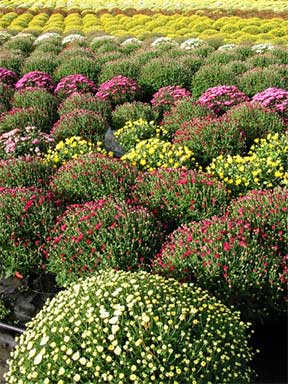Here are 20 Tips for you to Grow your own Big Chrysanthemums flowers!
- Hold stock plants in a coldframe for protection over winter, show new growth by late April or early May when divisions or cuttings may be taken.
- Divisions or single plants can be separated from the older clump or stock plant. Woody growth towards center should be discarded.
- Cuttings are made by removing the top 3 or 4 inches of new growth from stock plants with a sharp knife. Cut should be made below a leaf node.
- A coldframe is a convenient place to root cuttings. Fill it with sand, firm and level the surface. Soil heating cable under sand hastens rooting.
- Cuttings are dipped in a root stimulant, firmed in sand and watered. Glass is shaded with paper placed over frame. Frame should not be airtight.
- Rooted cuttings may be removed from the sand after two to four weeks or when roots are about 1/2 inch long. They are planted in at well-prepared soil.
- A nursery bed is a convenient place to set rooted cuttings until space is available in the border. They may be easily watered and shaded from hot sun.
- Plants set in permanent quarters are spaced 12 inches apart for exhibition varieties and 15 to 18 inches for a mass display of garden varieties.
- Watering is essential, but avoid wetting the foliage by using a ground soaker rather than a spray, except after transplanting as is being done above.
- Pinch out the top of the plant when it is 8 to 10 inches tall. Side branches will then form, but only three are allowed to remain. Cut off the others.
- Support for plants prevents wind and rain damage. Twine is tied between wires that stretch the length 0f bed or tie each plant to an individual stake.
- PVC pipes make an excellent framework for attaching supports. The wires may be moved higher as plants grow by raising the horizontal pipes.
- Exhibition chrysanthemums have been disbudded to allow but one bud to develop on each branch and pinched to permit growth of three stems per plant.
- Flowers open to reward the efforts of the gardeners; later varieties are still to bloom. Staking keeps plants erect and presents a neat appearance.
- An incurve variety has been disbudded and is compared with a plant that has been allowed to grow naturally. Disbudded one is for show.
- Garden varieties of the spoon and pompon types have been pinched twice to develop maximum branching. This provides a mass of bloom for the garden.
- Removable glass panels are placed over prize blooms when the weather turns cold or when winds threaten to topple plants, extending season a month or more.
- After blooming, stems are cut back to 4 inches. Most of the exhibition chrysanthemums must be moved to a coldframe for protection over Winter.
- Show time is more than the hope of prizes. It is the culmination of a dream, the matching of skills and the friendly give and take of vivid show experiences.
- The artist is not content to let the flowers remain in the garden but must bring them indoors to create a living picture for the family to enjoy.

